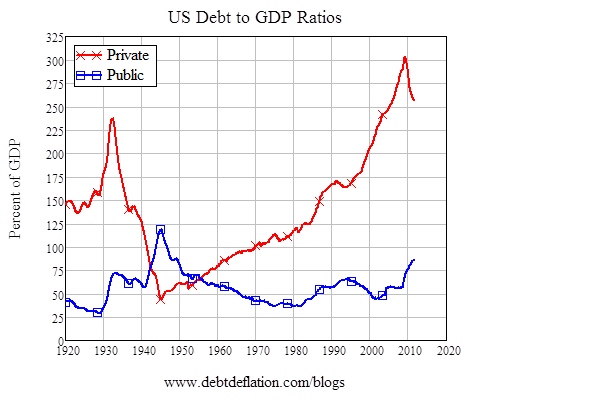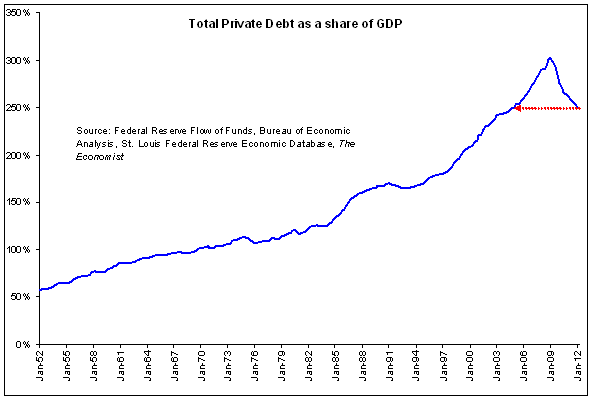How Far Will Deleveraging Go
Post on: 29 Апрель, 2015 No Comment

Credit will still have to shrink to keep leverage at precrisis levels.
David Roche
Updated Nov. 8, 2008 12:01 a.m. ET
The global economy is in recession. Will this lead to depression? And if not, how long and deep will the recession be? The answers to both questions depend on the extent of deleveraging by financial institutions.
The amount of risk-free or tier-one capital a bank is holding is a good reverse indicator of how leveraged it is. Globally, financial institutions had about $5 trillion of tier-one capital on the eve of the credit crisis. Those in the United States and European Union had about $3.3 trillion of tier-one capital supporting a loan book of some $43 trillion.
Then came the crisis.
How much did they lose? There are three answers. If mark-to-market rules are applied, global financial sector losses are estimated to amount to 85% of tier-one capital. But mark-to-market rules are extreme and assume the banks are insolvent and that all their assets will have to be fire-sold for whatever they can fetch in today’s dysfunctional markets.
If economic value, a concept based on the present value of future cash flows of the assets, is used instead, current losses are about half the amount calculated using mark-to-market rules.
Finally, if we use only the losses that have been recognized by the institutions themselves so far, we are a touch short of $700 billion.
Despite these losses, the loan books of banks have grown, not shrunk during the credit crisis. Only the balance sheets and leverage of the nondeposit-taking institutions, such as hedge funds, investment banks and prime brokers have shrunk, probably by 40%-60%.
All the bank losses have been offset by capital raisings of $420 billion from private sources and the promise of state capital injections of about $250 billion. The leverage of the U.S. and EU financial systems was 13 times tier-one capital before the crisis broke. Using mark-to-market rules, it is now more than double that. But using economic value or declared losses reveals that leverage is now back to what it was before the crisis began, thanks to capital raisings and the (assumed) full injection of promised state capital.
Why then is all not well and credit growth ready to resume? There are three reasons.
The first is that financial-sector leverage was too high before the credit crisis began, which is one good reason the credit bubble collapsed. All official reports that focus on never again prescriptions recommend a reduction in financial-sector leverage.
Second, the world economy has become accustomed to using $4 to $5 of credit for every $1 of GDP growth. Even if this profligate use of capital is halved, it still means credit expansion of 10%-15% is needed to achieve real GDP growth of 2%-3%. The recapitalization of financial institutions so far is only enough to maintain existing credit assets, but not expand them; ergo the credit crisis continues.
Third, the current bank-asset losses do not include any allowance for future losses which will result from global recession in (nonmortgage) consumer credit, leveraged buyouts and emerging-market, corporate foreign-currency debt. I estimate that, based on economic values, these losses will amount to a further $800 billion to $900 billion, putting total credit losses north of $1.7 trillion for the whole period of the crisis. Such future losses would eat up all the fresh capital contributions and reduce U.S. and EU financial institutions’ tier-one capital to around $2.3 trillion yet again. That implies a leverage ratio of more than 18 times.
It seems likely that leverage, and therefore credit, of the financial system will shrink, even with state capital injections of two to three times what we have already seen.
State injections are temporary, expensive and impose constraints on existing shareholders and management. The injection of state capital is therefore not really an attractive base for even maintaining current leverage and credit.
Also, there is a need to reduce the banks’ customer funding gap. In other words, banks will need to focus on deposit rather than loan growth. That is a slow process in a recessionary environment. So closing the customer funding gap in the initial years can only be achieved by reducing assets and liabilities. This means cutting credit on the asset side of the balance sheet.
In today’s Opinion Journal
REVIEW & OUTLOOK
COMMENTARY
- THE WEEKEND INTERVIEW: Rahm Emanuel

Jason L. Riley
Jim Towey
Richard N. Haass
David Roche
Nicole Gelinas
Then there is continued risk aversion in wholesale money markets, as well as in longer-term debt markets. This will deny banks easy finance to grow assets. Finally, regulation will reduce bank leverage to well below what it was before the credit crisis.
The bottom line is that, assuming further credit losses from global recession take U.S. and EU tier-one bank capital back to where it was before state injections and capital raisings, then financial-sector credit would have to shrink 37% just to keep leverage constant at precrisis levels — that’s how you get global depression.
But government is now part of bank management. Government intervention could manage to limit the credit decline to less than 10%, at the cost of more capital injections, further longer-term guarantees of liabilities, tolerance of higher leverage within socialized banks, and not a little credit dirigisme, i.e. directing banks to lend.
This will avoid the global depression that many fear, but at the high long-term cost of a socialized financial system. And it still heralds a very long, gray, global recession as the world learns to use less capital to meet its needs.
Mr. Roche is president of Independent Strategy, a London-based consultancy, and co-author of New Monetarism (Lulu Enterprises, 2007).
Please add your comments to the Opinion Journal forum .














